Disclaimer
Arthur Hughes
English Pre-Raphaelite Artist
1817 - 1904

Self Portrait of Arthur Hughes
The Pre-Raphaelite Brotherhood of English painters and poets was formed in 1848 in protest against the low standards of British art. The principal founders were D. G. Rossetti, W. Holman Hunt, and John Millais. In poetry as well as painting, the Pre-Raphaelites turned away from the growing materialism of industrialized England. They sought refuge, through literary symbolism and imagery, in the beauty and comparative simplicity of the medieval world. In the works of the Italian painters prior to Raphael, they found a happy innocence of style that they tried to imitate. Influenced by the Nazarenes, a similar group of German painters founded in Rome in 1810, the Pre-Raphaelites declared themselves devotees of nature and truth. In the early 1850's their works were violently criticized, first by Charles Dickens, as being vulgar and ugly. They were defended by John Ruskin and attracted numerous followers, among whom were Edward Burne-Jones, G. F. Watts, and William Morris, but the group disbanded after 1853 and the movement died out before the end of the century. The paintings of the Pre-Raphaelites are characteristically nostalgic in tone and bright in color. Despite their predilection for simplicity, they were highly meticulous in detail and mannered in style.
Arthur Hughes was born in London on 27 January 1832, to Edward and Amy Hughes. He entered Archbishop Tenison's Grammar School in about 1838, and while there displayed an early talent for drawing; in 1846 he entered the School of Design, Somerset House where he studied under Alfred Stevens. In 1847 he enrolled in the Antique Schools at the Royal Academy, winning a silver medal in 1849 for a drawing from the Antique, and in that same year exhibited his first finished painting, Musidora, at the Royal Academy. 1850 was the most important year of his life: he first discovered Pre-Raphaelitism by reading the Germ; he met Tryphena Foord, his future wife and mother of his six children; and met Alexander Munro, Dante Gabriel Rossetti, and Ford Madox Brown, thenceforward being converted to their cause. In 1852 he sent Ophelia (c.1851-53, City of Manchester Art Galleries) to the Royal Academy, and the following year began Orlando, which during the next six years evolved into The Long Engagement. In 1856 Hughes exhibited two of his best paintings at the Royal Academy, The Eve of St. Agnes and April Love, the latter being purchased from the exhibition by William Morris. In 1857 he joined with Rossetti, Morris, Edward Burne-Jones and others in painting murals on the walls of the Oxford Union Debating Hall (now the Library), an effort which perhaps inspired his later Arthurian works such as The Knight of the Sun and Sir Galahad. Another well-known painting, Home from Sea (1856-63, Ashmolean Museum, Oxford), was begun at Chingford, Essex in 1856, but not completed until 1862-63 when the figure of the girl, modeled by Tryphena, was added.
Ophelia: 1851-53
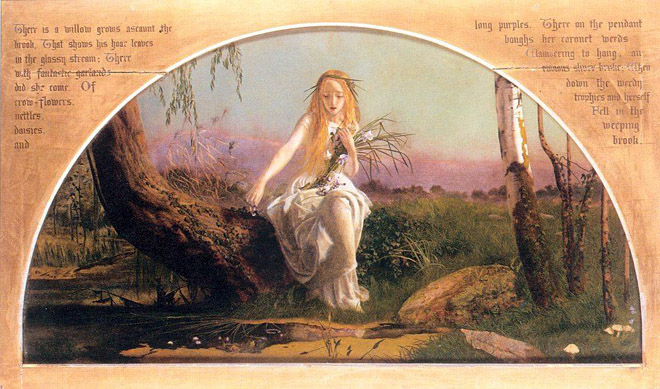
Arthur Hughes was only 19 years old when he painted Ophelia.
It is based on a speech in Shakespeare's play Hamlet.
Ophelia is driven to madness by Hamlet's murder of her father and rejection of her love.
We see her moments before she drowns.
Queen Gertrude's speech in the play, describing Ophelia's death, is inscribed on the frame.
Ophelia
(And will he not come again): ca 1863-71
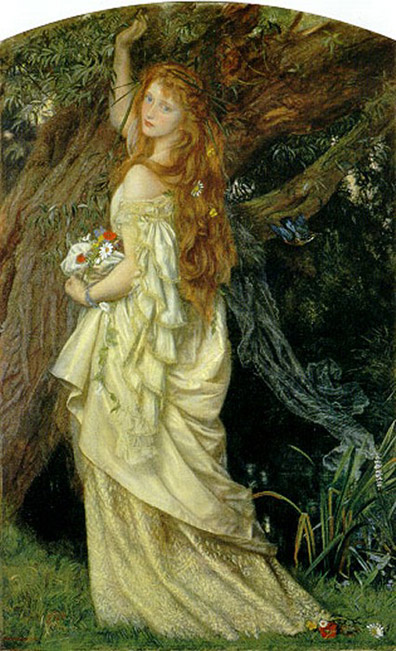
A sketch of ca. 1863 for the painting completed in 1871. It illustrates the scene in Shakespeare's Hamlet (Act IV, scene 7) in which Ophelia picks flowers to make garlands shortly before she is drowned.
The Long Engagement: ca 1854-59
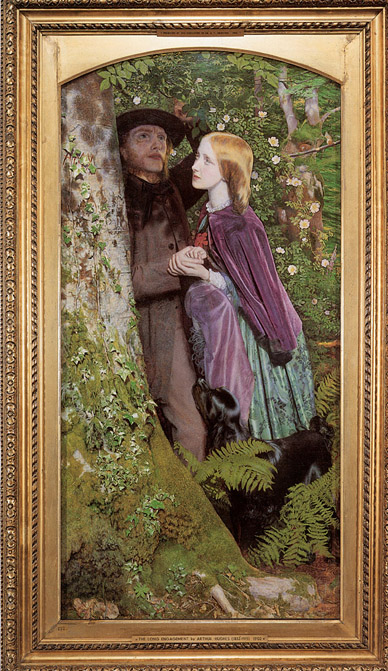
In this scene, a clergy man meets his lover. As a poorly paid cleric, he is presumably too poor to marry - perhaps even to become formally engaged, as the young woman's hand displays no engagement ring. The length of their courtship is indicated by the ivy having grown over her name, Amy, which was cut long ago into the tree.
The Eve of Saint Agnes: 1856

This work was inspired by John Keats's poem The Eve of Saint Agnes which was published in 1820. Hughes depicts three incidents from the poem. The frame is inscribed with the fourth verse which sets the scene for these episodes: Porphyro's approach to the castle, where a lavish banquet is in progress; his awakening of Madeline from her dreams; and the lovers' silent escape from the dark castle into the night. The painting was exhibited at the Royal Academy the same year as Hughes's April Love. John Ruskin described it as 'A noble picture... the face of the awakening Madeline is exquisite'.
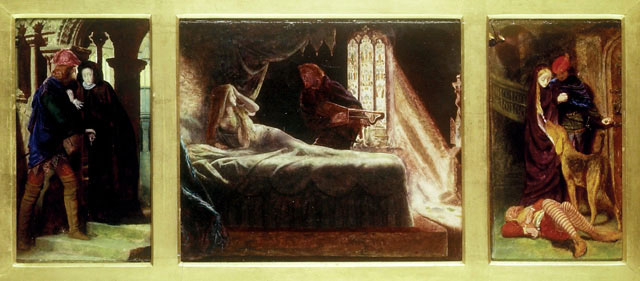
April Love: 1855-56
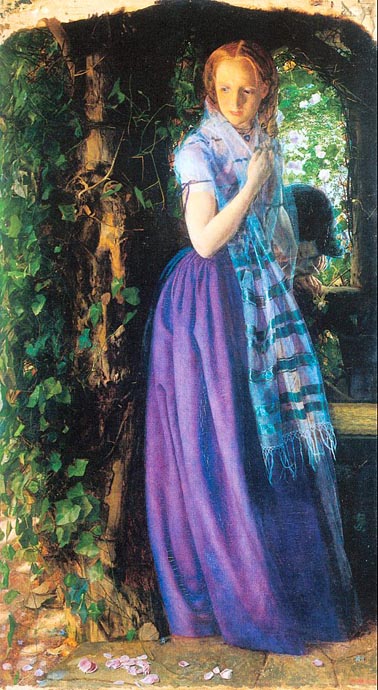
A young woman looks down at fallen rose petals as her suitor bends to kiss her hand. The petals symbolize the fragility of young love, the theme of this courtship scene. Arthur Hughes heightened the painting's emotional charge by using deep and vivid colors. He had married 'his early and only love', Tryphena Ford, in the winter before this painting was first exhibited. The scrupulous depiction of naturalistic detail and texture here shows great dexterity and was greatly admired by the critic John Ruskin. The painting was bought by the writer and design entrepreneur William Morris.
The Knight of the Sun
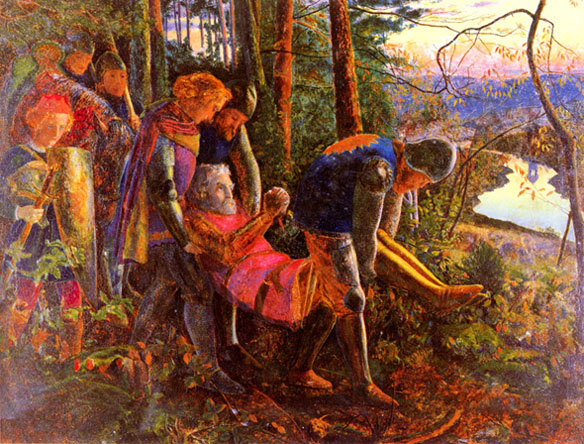
Sir Galahad: 1865-70

Inscribed on the back:
The clouds are broken in the sky,
And thro' the mountain-walls,
A rolling organ-harmony
Swells up, and shakes and falls,
Then move the trees, the copses nod,
Wings flutter, voices hover clear:
Oh just and faithful knight of God!
Ride on: the prize is near.
So pass I hostel, hall, and grange;
By bridge and ford, by park and pale,
All-arm'd I ride, whate'er betide,
Until I find the holy Grail'.
A gentle sound, an awful sight!
Three angels bear the holy grail:
With folded feet, in stoles of white,
On sleeping wings they sail.
Sir Galahad: ca 1894
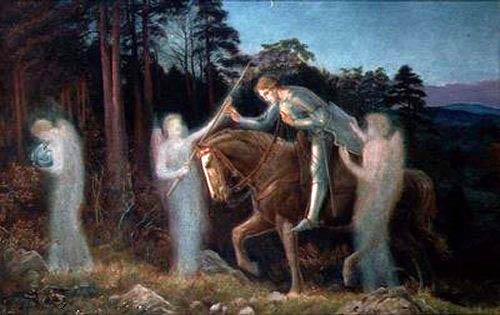
Home from Sea: 1856-57
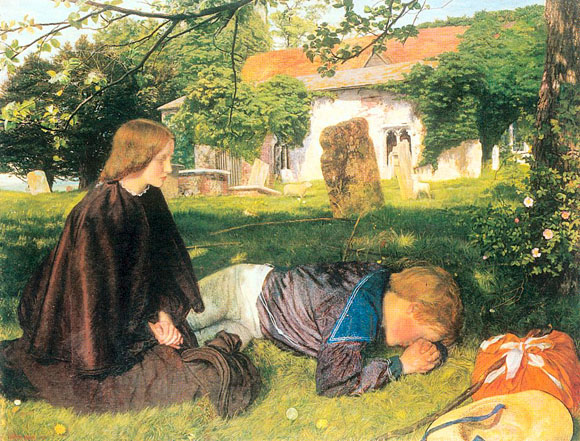
The genesis of this painting began in 1857, when it was exhibited as The Mother's Grave. The original composition, known from a drawing in the Ashmolean, showed the boy desolate over the grave of his mother. The landscape was begun in the summer of 1856 in the old churchyard at Chingford, Essex. Around 1862, Hughes altered the background and added the figure of the sister, for which the artist's daughter, Tryphena, posed. The detail is used to reinforce the pathos of the subject, so that the ephemeral nature of spider's webs, dew drops, dog roses and dandelion seeds all emphasize the theme of transience. The boy's loss is retold in the lamb separated from its mother by the barrier of the tomb.
As well as being the best of the younger Pre-Raphaelite followers, Hughes was one of the leading book illustrators of the 'Sixties' school, producing drawings for Tennyson's Enoch Arden, Thomas Hughes's (no relation) Tom Brown's School Days, and George MacDonald's At the Back of the North Wind and The Princess and the Goblin.
Hughes's only official post was Art Examiner in the South Kensington Schools, although he taught from January to August 1877 at the Working Men's College. In 1912 he was awarded a Civil List Pension, and on 23 December 1915 he died in Kew Green, London, having produced approximately 700 known paintings & drawings and 750 book illustrations during his lifetime.
Biography by Leonard Roberts
From: ArtMagick
Hughes showed early artistic promise and enrolled in the Royal Academy Antique School in 1847. He was encouraged by Millais, who was always an affable individual. Hughes was inspired directly by The Germ, the short-lived Pre-Raphaelite magazine. He attended PRB meetings, in rather a junior hero-worshipping manner. Hughes was liked by the PRB, in fact he was throughout his long life, a well liked individual. He was also encouraged by Rossetti.
Hughes main traits as an individual were his modesty and self-effacement. He suffered somewhat at the hands of the Royal Academy, having a number of ill-merited rejections, and very badly hung pictures. He was never even elected an Associate. Hughes married, in 1855 Tryphena Foord, the union was lasting, and happy. As well as the limits imposed by his shyness and modesty, Hughes was motivated by the desire for a stable, happy family life. Ultimately he was prepared to compromise artistic ambitions for this. Many of his pictures were of ordinary scenes of life. They were painted with great delicacy, and feeling, and were often in greens and mauves. Like the great orchestral composers, the warm sympathetic character of the man shines through in his work. William Michael Rossetti, writing about Hughes said "If I had to pick out, from my once numerous acquaintances of the male sex, the sweetest and most ingenuous nature of all, the least carking and querulous, and the freest from envy hatred & malice, and all un-charitableness, I should probably find myself bound to select Mr. Hughes." Should any human being have a better character reference, or epitaph than this I have yet to see it.
Following the death of Tryphena Hughes in 1921, their daughter Emily had to move to a smaller house. There was, therefore, a shortage of space. As a result she had her father's remaining preparatory sketches, and all his private papers and correspondence destroyed. What an appalling act of artistic and historical vandalism!
Source: Victorian Art in Britain
From: Art Renewal Center
A Music Party: 1861-64
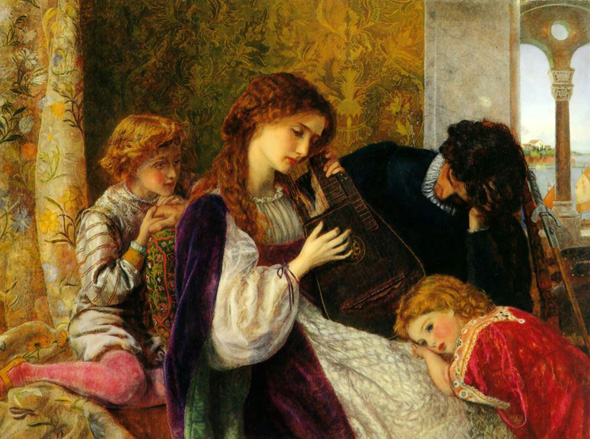
When exhibited at the Royal Academy in 1864, the accompanying lines from John Keats' Ode on a Grecian Urn were included in the catalogue:
'Heard melodies are sweet, but those unheard are sweeter
Not to the sensual ear, but more endear'd
Pipe to the spirit ditties of no tone.'
A Spring Afternoon
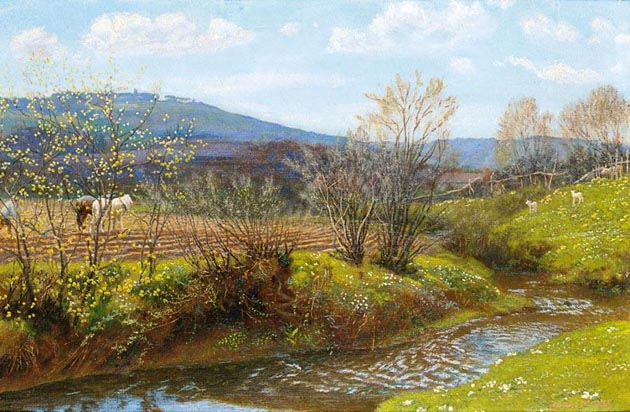
Asleep in the Woods

Aurora Leigh's Dismissal of Romney - (The Tryst): 1860
 _1860.jpg)
This painting illustrates the poem Aurora Leigh by Elizabeth Barrett Browning. Aurora is an aspiring poet. Her cousin Romney has proposed marriage but she rejects him in order to follow her vocation as a writer. She holds a book of her poems that Romney has derided in the past. This underlines her rejection of his offer to be his companion and helper. The poem describes Aurora dressed in white but here Arthur Hughes uses an unusual green to complement the garden setting. The white lilies symbolize Aurora's purity and the single life she may lead dedicated to her art.
AURORA LEIGH
A POEM
Elizabeth Barrett Browning
Beauty and the Beast: 1863-65
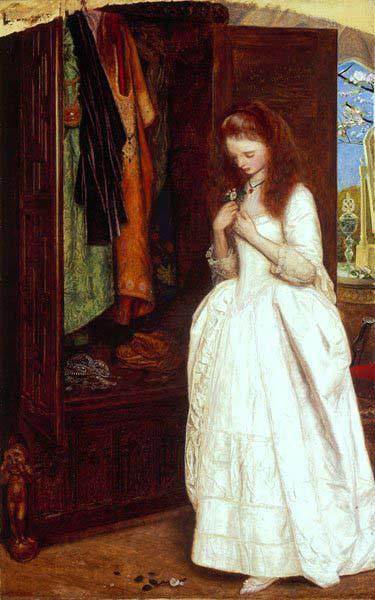
Hughes had chosen Mary MacDonald as the model for Beauty. The subject for the painting came from Jeanne-Marie Leprince de Beaumont's classic eighteenth century fairytale, La Belle et la Bete. The origins of the story can be traced to Lucius Apuleius's Cupid and Psyche (2nd Century AD). Psyche, the third and most beautiful daughter of the King, is cursed by Venus to fall in love with the most miserable creature living, the most poor, the most crooked, and the most vile, that there may be none found in all the world of like wretchedness. The earliest version of La Belle et la Bete was written by Madame Villeneuve in 1740, a story laced with Baroque theatrical extravaganzas, very different to de Beaumont's more straightforward interpretation. Hughes depicts the scene in de Beaumont's tale in which Beauty is granted a week of freedom from the Beast's enchanted castle to spend with her beloved father. She awakes to find a chest of beautifully embroidered gowns of jewel-like colors, a gift from the Beast, although in her modesty she chooses the plainest:
"You shall be there tomorrow morning", said the Beast, "but remember your promise. You need only lay your ring on a table before you go to bed, when you have a mind to come back. Farewell Beauty." Beast sighed, as usual, bidding her good night, and Beauty went to bed very sad at seeing him so afflicted. When she awaked the next morning, she found herself at her father's, and having rung a little bell, that was by her bedside, she saw the maid come, who, the moment she saw her, gave a loud shriek, at which the good man ran up stairs, and thought he should have died with joy to see his dear daughter again. He held her fast locked in his arms above a quarter of an hour. As soon as the first transports were over, Beauty began to think of rising, and was afraid she had no clothes to put on; but the maid told her, that she had just found, in the next room, a large trunk full of gowns, covered with gold and diamonds. Beauty thanked good Beast for his kind care, and taking one of the plainest of them, she intended to make a present of the others to her sisters. She scarce had said so when the trunk disappeared. Her father told her, that Beast insisted on her keeping them herself, and immediately both gowns and trunk came back again.
Hughes had chosen this particular passage to emphasize humility and avoidance of vanity. He had just returned from a 'grand tour', which had been funded by his wealthy new patron John Hamilton Trist. He had marveled at the fashions, art and architecture in the medieval towns of Nuremberg, Cologne, Verona, Padua and, most importantly, Venice, describing the church of San Marco as a fairy palace out of the Arabian Nights. In addition, in Venice he admired and studied the works of Bellini with their 'great color' and 'understanding of texture'. Here was the inspiration for the Beast's gifts of rich fabrics, extraordinary gowns and magnificent jewelery.
Benedick in the Arbor: 1852-54
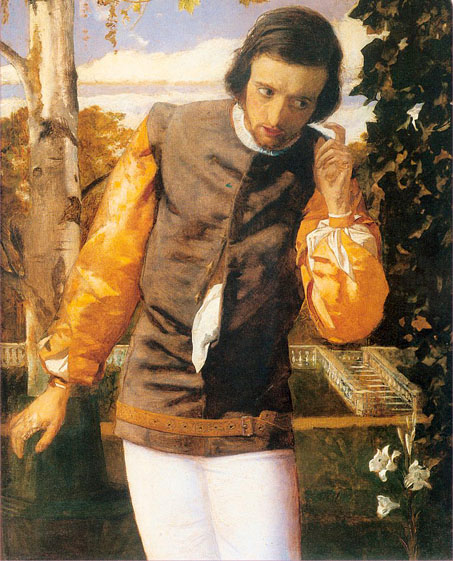
Cecily Ursula - aged three years
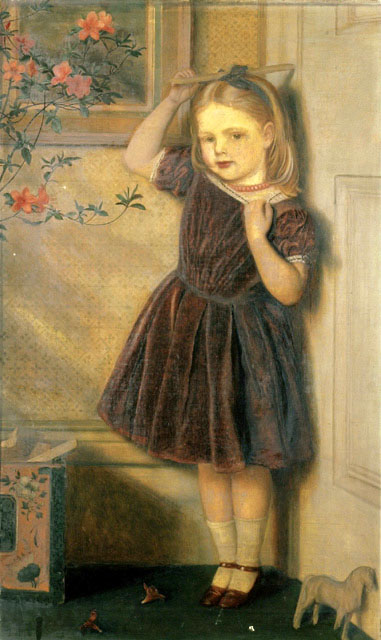
Cecily Ursula Palgrave was the daughter of the critic, Francis Turner Palgrave. She is seen measuring her height against a door. This work was exhibited at the Royal Academy in 1867.
Edward Robert Hughes as a Child: 1854-55
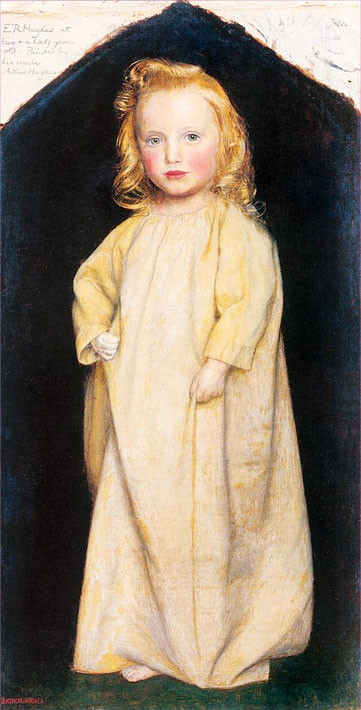
Endymion: 1868-70
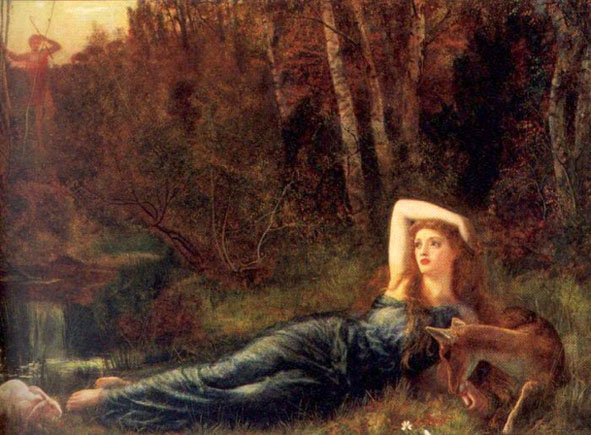
'Brain-sick shepherd prince,
What promise hast thou faithful guarded since
The day of sacrifice? or have new sorrows
Come with the constant dawn upon thy morrows?
Alas! 't is his old grief. For many days
Has he been wandering in uncertain ways,
Through wilderness and woods of mossed oaks'
Fair Rosamund: 1854
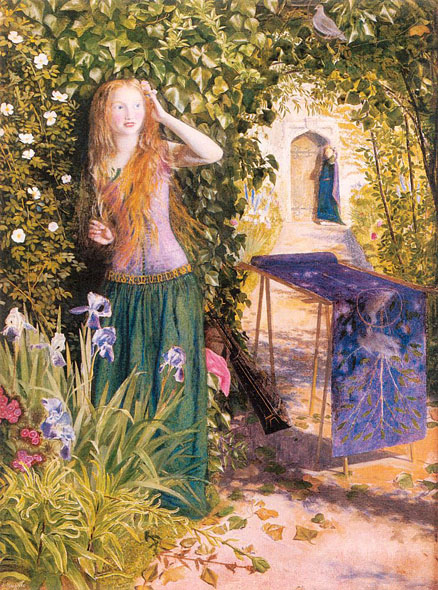
Rosamund, according to a medieval story, was the mistress of Henry II and was poisoned by his wife, Queen Eleanor. The King kept Rosamund hidden from the world in a house that was surrounded by an elaborate maze. The Queen, jealous of her rival, found a way to penetrate the maze, after which Rosamund, 'lived not long'. The painting shows the Queen entering the garden. Rosamund is surrounded by flowers, symbolizing love and pain and secrecy, her fall is symbolized by a broken plant, while her pastimes are indicated by the stringed instrument and the printed textile.
Good Night: 1865-66

'Day's turn is over: now arrives the Night's.'
In the Grass: ca 1864-65
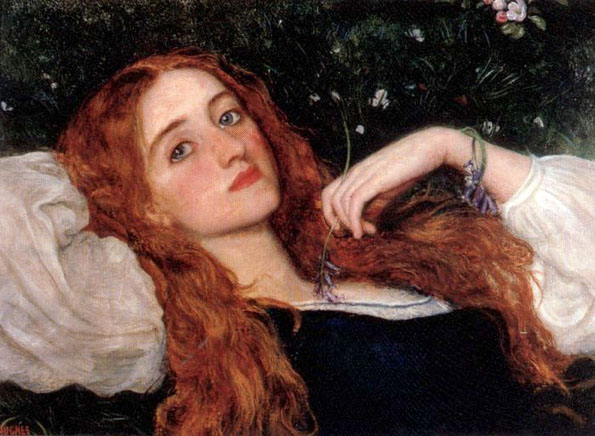
La Belle Dame Sans Merci

"La Belle Dame sans Merci" ("The Beautiful Lady without Pity") is a ballad written by the English poet John Keats. It exists in two versions, with minor differences between them. The original was written by Keats in 1819, although the title is that of a fifteenth century poem by Alain Chartier.
The poem describes the encounter between an unnamed knight and a mysterious fairy. It opens with a description of the knight in a barren landscape, "haggard" and "woe-begone". He tells the reader how he met a beautiful lady whose "eyes were wild"; he set her on his horse and she took him to her "elfin grot", where she "wept, and sigh'd full sore". Falling asleep, the knight had a vision of "pale kings and princes", who cried, "La Belle Dame sans Merci hath thee in thrall!" He awoke to find himself on the same "cold hill's side" where he is now "palely loitering".
Enjoying "La Belle Dame Sans Merci", by John Keats
Lucy Hill: 1888
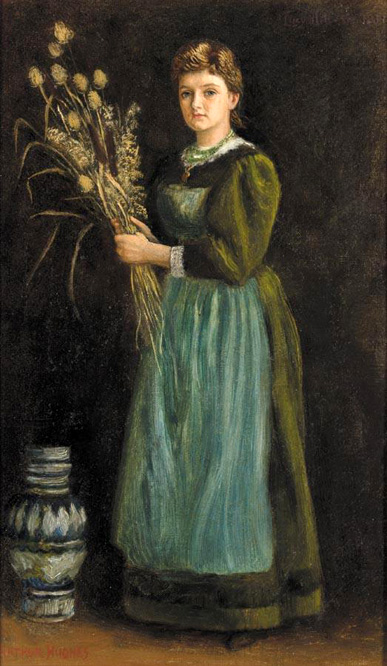
Lucy Hill and her family were life-long friends of Arthur Hughes. He also painted her, along with three of her siblings, in 1866 (The Children of George Birkbeck Hill, Bruce Castle Museum, Tottenham). Hughes visited William Bell Scott at Penkill Castle from 7 to 21 October 1887, and the present portrait was finished soon after his return to Wandle Bank. Lucy was the great-niece of Sir Rowland Hill, post office reformer and inventor of the penny post. Her father, George Birkbeck Hill, edited the Letters of Dante Gabriel Rossetti to William Allingham (Fisher Unwin, 1897) and she herself edited The Letters of George Birkbeck Hill (Arnold, 1906). Lucy's husband-to-be was related to an Editor of The Times, and another of his relatives founded a maritime law-firm known as Crumps.
Attached to the reverse of the panel is a note written by a subsequent owner which reads: "Inscribed on an original label on this picture was 'To Mary Manson from Lucy Crump 1864-1887 ~ 1938. Contre mauvaise fortune bon couer'. Lucy and Charles Crump were neighbors of the Mansons. Arthur Hughes (1832-1915) is the artist. The subject is understood to be Lucy as a young girl. The Crumps had work by J.B. Manson (director of the Tate Gallery, 1930-8). Mary was his eldest daughter and taught music at the North London Collegiate School."
Mariana at the Window: ca 1865-67

"Oil on board; signed with monogram; inscribed on old label verso by A.F. Hughes: "A Study/painted about 1856".
The subject is taken from Tennyson's poem, Mariana:
"She drew the casement-curtain by,
And glanced athwart the glooming flats.
She only said, 'The night is dreary,
He cometh not,' she said;
She said, 'I am aweary, aweary,
I would that I were dead!'".
Alfred Lord Tennyson's Mariana
Old Neighbor Gone Bye
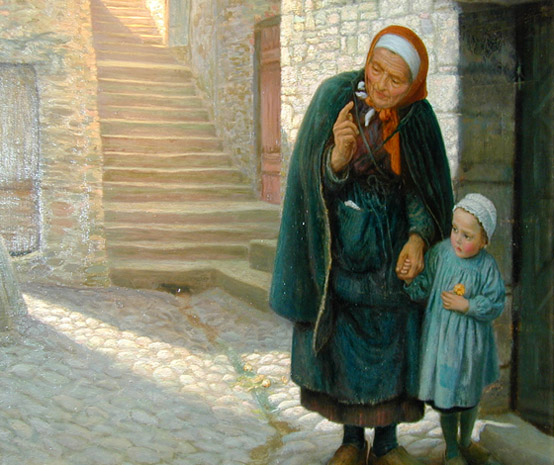
Overthrowing of the Rusty Knight

A beautiful young maiden turns with a look of yearning gratitude, to face a victorious knight resplendent in his armor who has vanquished the villain who threatened her purity. The opponent lies lifeless in the stream beneath an ancient bridge where the joust has recently taken place, and the breath of valiant knight's horse still heated from the combat, hangs in the chill autumn air. This is the moment of anticipation between the fight and the moment when the knight which take the indebted maiden in his arms.
The subject of 'The Overthrowing of the Rusty Knight' is taken from Tennyson's tale of medieval romance and chivalry, Gareth and Lynette and the moment depicted is immediately following the hero Gareth's victory over the tyrant Evening, who had captured Lynette and tied her to a tree. The poem Gareth and Lynette was written in 1872 for 'The Idylls of the King', the most influential modern reinterpretation of Arthurian legend of the Nineteenth Century and one of Tennyson's most widely illustrated texts.
Gareth the son of Lot and Bellicent, and the beautiful maid Lynette, are the main protagonists in Tennyson's tale of the kitchen knave who wins the heart of the beautiful and high-born Enid, whom he saves from the rusty knight, encouraged by Enid's words; "Well done, knave-knight, well stricken, O good knight-knave, O knave, as noble as any of all the knights, Shame me not, shame me not. I have prophesied, Strike, thou art worthy of the Table Round, His arms are old, he trusts the hardened skin, Strike--strike--the wind will never change again." Tennyson leaves the conclusion of the romance enigmatic and we are unsure whether Lynette and Gareth are eventually united and live happily ever after, the last lines of the poem reading, 'And he that told the tale in older times, Says that Sir Gareth wedded Lyonors, But he, that told it later, says Lynette.'
Hughes had been interested in tales of Medieval romance since the 1850's when he contributed to the famous decoration of the Oxford Union Murals, with his 'The Death of Arthur', and notable examples of paintings based upon episodes from Tennyson's poetry of knights and maidens include La Belle Dame Sans Merci of 1861-3 (National Gallery of Victoria, Melbourne), Enid and Geraint of 1859 (private collection) and The Lady of Shallot of 1872-3 (private collection). Hughes typically chose the moments of heightened emotional charge in which hearts pound with desire as lovers embrace or break at the moment of parting. With 'The Overthrowing of the Rusty Knight', which was begun around 1894 but not completed until 1908, the tension is caught between the archetypes of medieval romance, the knight and the pure hearted and the virtuous maiden. This idea of 'historic' chivalry was a theme which counteracted the socio-realist dramas which vied for attention in the same exhibitions. Chivalric paintings, writings and theatrical performances offered the Victorian audience an escape to an imagined age of romance.
The 'Overthrowing of the Rusty Knight' appears to have been inspired by Frank Dicksee's Chivalry of 1887 which in turn had been suggested by Millais' The Knight Errant. The subject of chivalrous knights and bound damsels was popular for Victorian artists and had its classical counterpart in the story of 'Perseus and Andromeda'. Hughes painted another similar subject of a knight rescuing innocent children from the clutches of a dragon in his triptych of 1907-08 entitled 'The Rescue' (now dismantled and separated). Hughes' work on 'The Rescue' may have determined him to take up the incomplete 'The Overthrowing of the Rusty Knight'.
Tennyson's "Gareth and Lynette"
Pansies
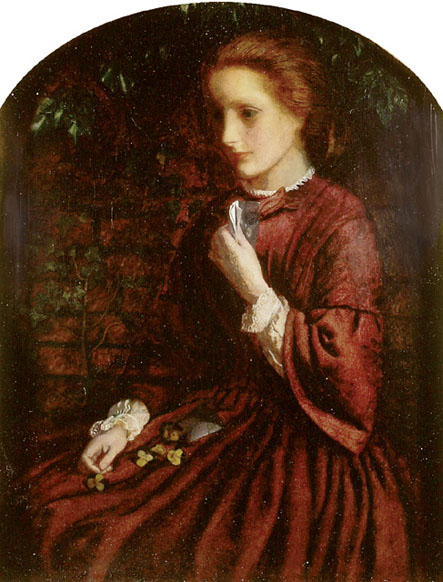
The girl clutches a letter that has moved her deeply. She holds on her lap yellow pansies, the flower of memory. The scene is characteristically suggestive and affecting and recalls the theme of Hughes's 'April Love' of 1856 (Tate Britain). Pansies was probably painted around 1860.
Perran Point - Cornwall
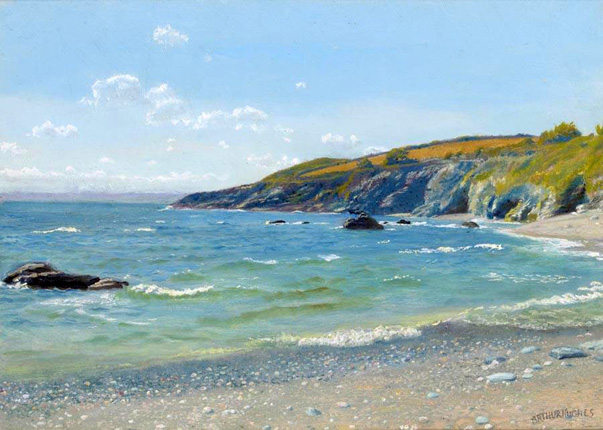
According to Leonard Roberts 'Perran Point' was painted around 1895 at a time when Arthur Hughes painted several charming marine studies in Cornwall, including 'Newquay Headland From the Warren', 'The Towan', 'Newquay and Saint Agnes' Head', Cornwall. In each of these small panels Hughes captured the rugged wilderness of the Cornish coast in times of tranquility when the cliff-tops are covered by a verdant wealth of grass and salt-loving flowers and the sea is a beautiful shade of azure blue. His studies of ocean from the vantage of the cliffs found its most impressive expression in the two versions of 'Threads of Fate' in 1887 and 1889 in which a young women is mending the nets on a rock far above an inlet where a solitary fisherman is rowing into shore. Around 1889 Hughes also painted the similar painting 'A Cornish Welcome' in which two young children wave from the cliff tops at the unseen fleet below.
Hughes continued to paint these views throughout his life and clearly found great pleasure in landscape painting, for which he had a great talent. Although he is now well known for his Pre-Raphaelite romantic paintings of knights and damsels, his quality as a landscape painter is perhaps not as recognized as it should be.
Phyllis
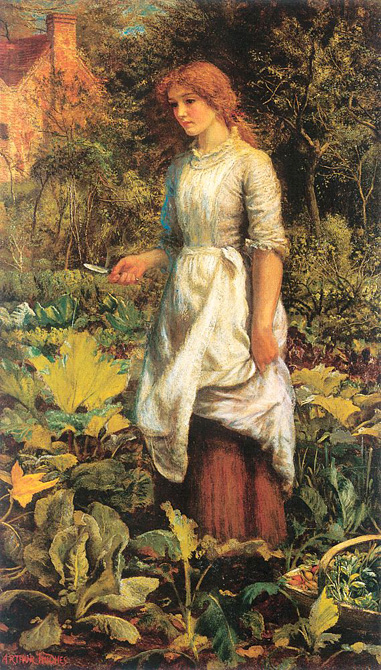
Portrait of an Elderly Woman: 1851
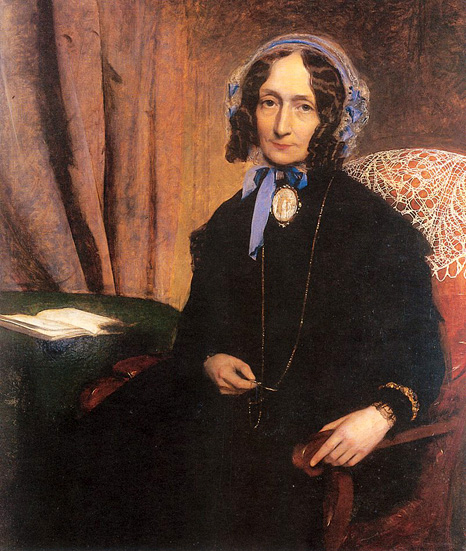
Mrs Norman Hill and Children: 1897
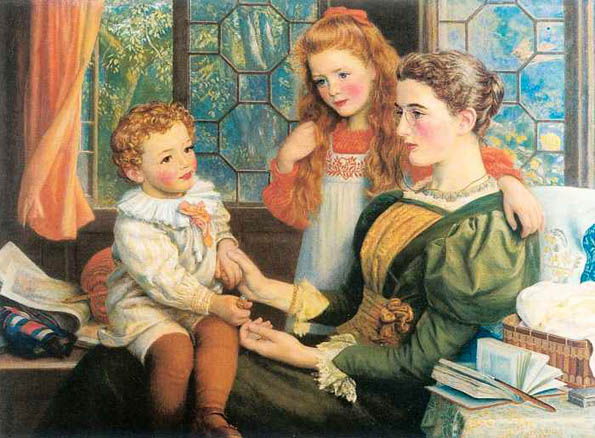
Mrs James Leathart and Children: 1863-65
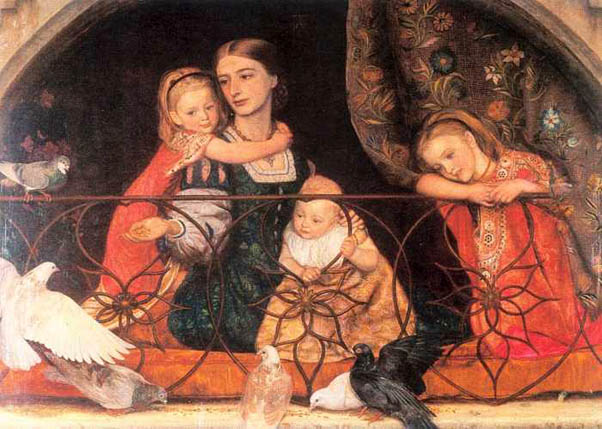
The Newcastle industrialist and art collector James Leathart commissioned this portrait of his young family from Arthur Hughes, who was one of the younger generations of Pre-Raphaelite artists. The faces of the family were painted from life at their Gateshead home. The balcony format is influenced by 16th-century Italian Renaissance pictures, and Mrs Leathart is shown in a Renaissance-style dress. Reflected light from the dress creates a bright green shadow on the baby's bib. The artist used a Pre-Raphaelite technique of painting bright, pure colors over a white under-layer to increase the intensity of the colors. Pigeons flying into the scene give it an informal quality.
Portrait of Ellen Dana Conway: 1873
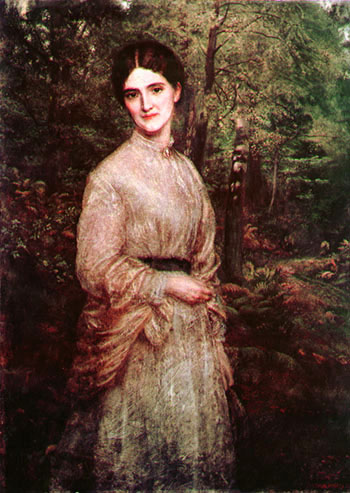
Portrait of Mrs Louisa Jenner: 1867
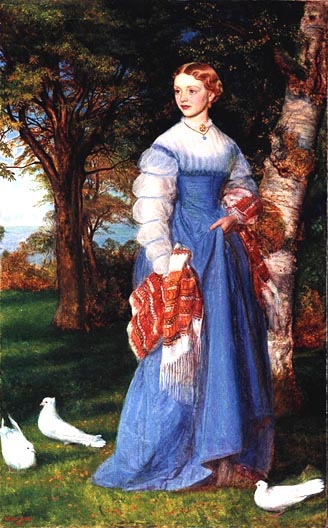
When taking into account the similarities between Mrs Thomas Woolner and Mrs Louisa Jenner, we can assume that Charles Jenner was aware of the former and wished to possess a similar likeness of his young wife (she was her husband's junior by 23 years). Both portraits place the sitter standing, full-length, in a highly-detailed part-wooded landscape; her arms draped with a scarf and her head turned aside. Further evidence of this connection derives from comparing Mrs Woolner's portrait to the early study for Mrs Jenner. They reveal near- identical attitudes: both women standing to the right while facing to the left, with their right arms across their midriffs. It is also interesting to note that the pigeons at Mrs Jenner's feet are reminiscent of those depicted in Mrs James Leathart.
That was a Piedmontese: 1862
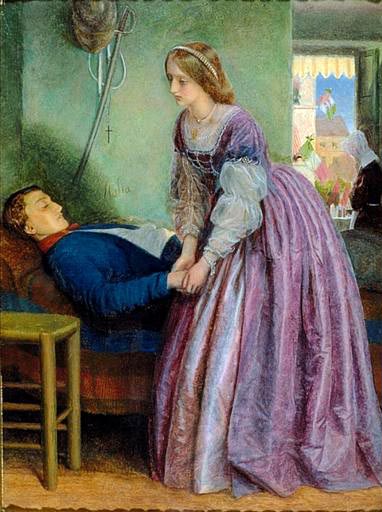
In this painting Hughes illustrates the last verse of Elizabeth Barret Browning's poem 'A Court Lady', the final line of which is inscribed on the frame. He began work on the picture soon after the poem was first published in 1860. The poem concerns a beautiful young woman who visits injured and dying soldiers dressed in her finest court wear that normally reserved for audiences with the King. Instead of a death scene of 'fervid impassioned exclamation', Hughes set out to paint 'the quiet moment that must have followed it'. The picture was commissioned by Ellen Heaton, who also owned Hughes's painting 'Aurora Leigh's Dismissal of Romney'.
A Court Lady by Elizabeth Barrett Browning
The Annunciation: ca 1858

The Brave Geraint: 1860
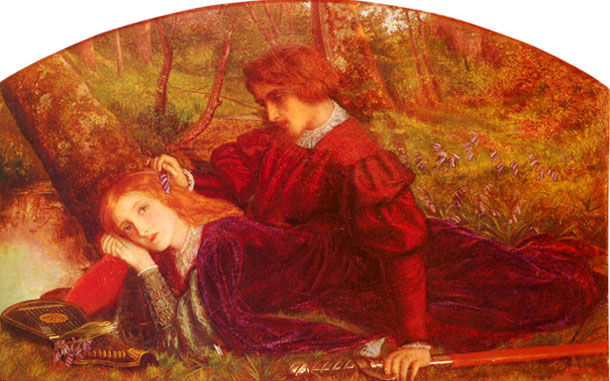
'The Brave Geraint, a Knight of Arthur's court,
Had married Enid, Yniol's only child,
And loved her, as he loved the light of Heaven.
He compass'd her with sweet observances
And worship, never leaving her, and grew
Forgetful of his promise to the King,
Forgetful of the falcon and the hunt,
Forgetful of the tilt and tournament,
Forgetful of his glory and his name,
Forgetful of his princedom and its cares.'
The Convent Boat: 1873-74
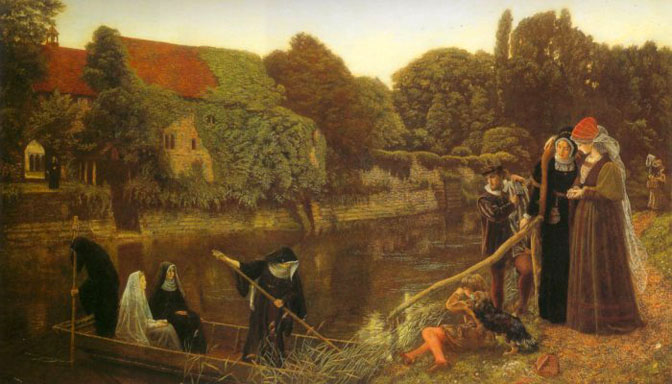
This work appears to be a preparatory study for 'The Convent Boat', Hughes's masterpiece of the 1870's. The final version depicts an affluent family mourning on a bank as their beloved daughter and sister, dressed in novitiate white, is rowed across a moat to enter the convent from which she will never emerge. A sense of loss and melancholy pervades the picture, reinforced by the fading light and autumnal landscape. The effect of the whole found parallels in French Symbolism. The canvas was originally exhibited at the Royal Academy of 1874.
The Heavenly Stair: ca 1887-88
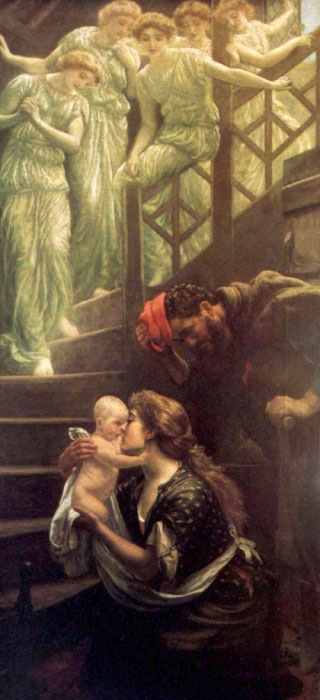
'Little one who straight
has come down the heavenly stair.
Our birth is but a sleep and a forgetting:
The Soul that rises with us, our life's Star,
Hath had elsewhere its setting,
And cometh from afar:
Not in entire forgetfulness,
And not in utter nakedness,
But trailing clouds of glory do we come
From God, who is our home.'
The King's Orchard (Study): ca 1857-62
_ca_1857_62.jpg)
The King's Orchard: ca 1857-62
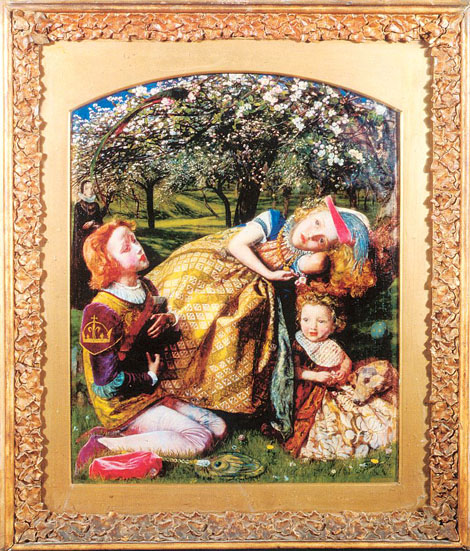
The Lady of Shalott: ca 1872-73
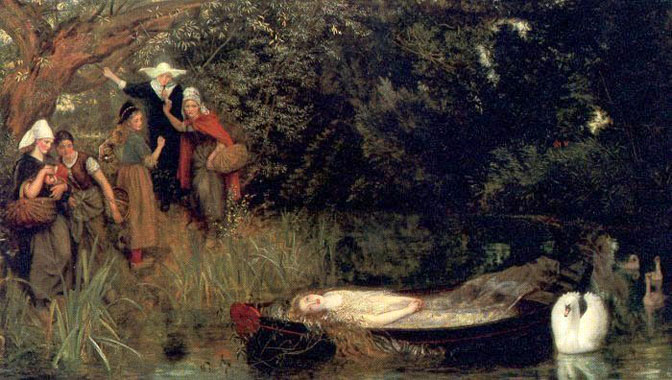
'Out upon the wharfs they came,
Knight and burgher, lord and dame,
And round the prow they read her name,
The Lady of Shalott'
The Lady of Shalott by Alfred Lord Tennyson
The Nativity: 1858
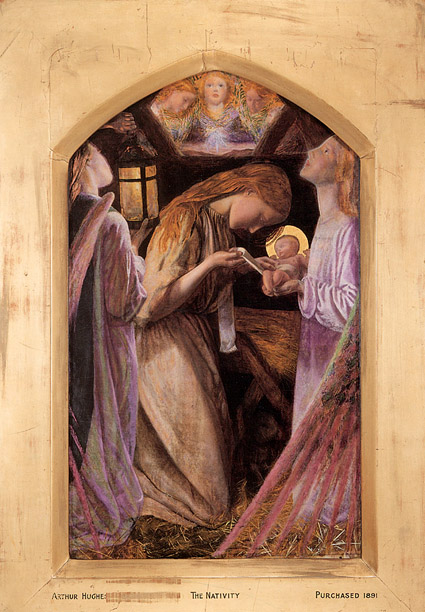
The Pained Heart
(aka Sigh no more ladies, sigh no more): ca 1867-72

This is an important study, previously believed un-located, for Hughes's painting 'The Pained Heart' (which also bears an old label inscribed 'Sigh no more, ladies'). The picture, one of Hughes's most enticing, was conceived in 1867-68 and reworked in 1872. This study chronicles the original version, exhibited in the Royal Academy in 1868 (but without a title); and, as Leonard Roberts points out in his catalogue raisonée of Hughes, shows one figure rather than the two represented in its final metamorphosis.
The quotation, from Much Ado about Nothing, provides us with a generic conception of the picture's subject: a young girl who wistfully dreams of her beloved. However, 'The Pained Heart' is also identified as 'Juliet and her Nurse' in an inscription on the old label. Although this is not in the artist's hand, the second figure (who appears in 1872) does resemble Juliet's nurse; attired in matronly black and white, kindly of demeanor, she leans down to console her melancholy ward.
Many details concur between this and the present study, however. In both the girl is seated before a casement window, which is partially obscured by a fine veil-like curtain, and wears a medieval-style dress with gathered sleeves. However in the present study she sits beside a neglected sewing frame. The motif is concordant with Romantic ideas of frustrated feminine desire - Tennyson's Mariana and Keats's Lady of Shalott being the archetypes: heroines who disown industry for love. Indeed, Mariana in the moated grange, shows Hughes developing his conception with Tennyson's poem in mind; here the girl is entertained by a young lute-player, whose song perhaps articulates her dreams.
The Property Room: 1879
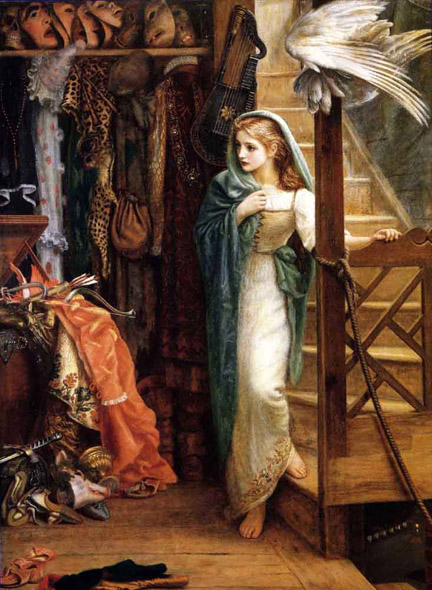
The Sailing Signal Gun
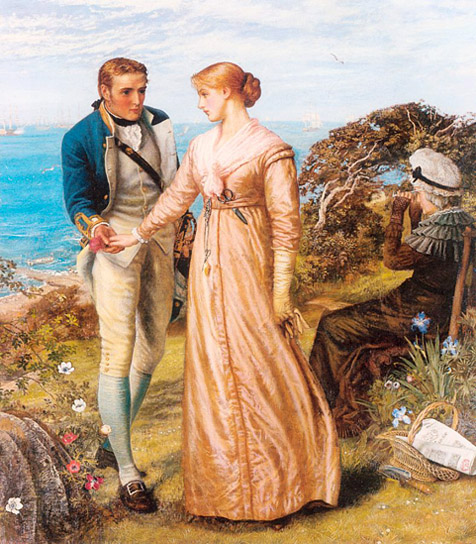
The Scythe Sharpener
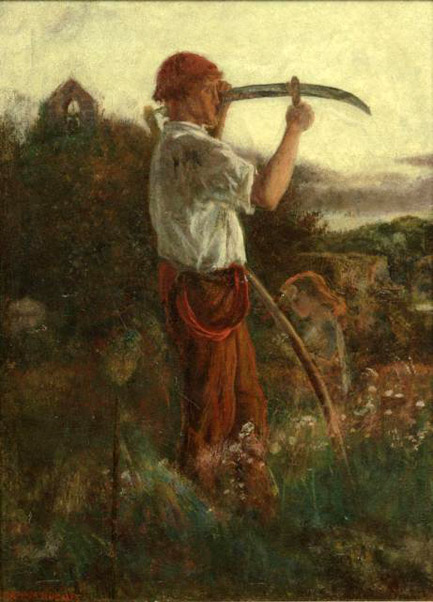
The Woodman's Child: 1860

A child sleeps while her parents are at work in the woods beyond. Such a scene is a development of the genre paintings of Wilkie and Mulready, who had been pre-eminent in establishing the Victorian taste for depictions of everyday life. The Pre-Raphaelite virtue of truth to nature is thoroughly honored in this picture, where the various elements are painstakingly observed as if they were a still life. The soft autumn colors perhaps suggest ideas of mortality. However, the child is in no immediate danger, watched over by a squirrel and a robin. Hughes very probably used his own daughter as the model for the sleeping girl.
The Yellow Sand: 1891
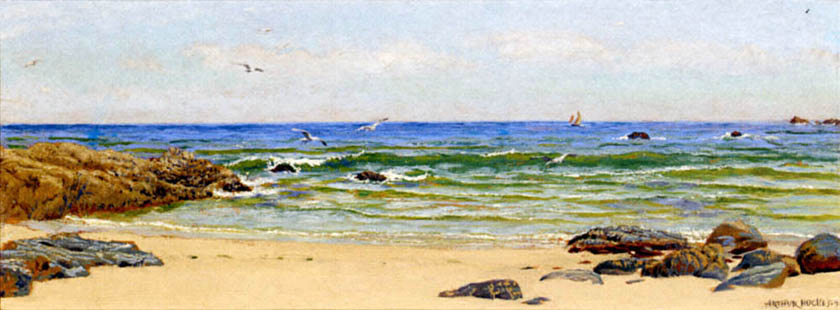
The Young Poet: ca 1849

Vanity Fair: ca 1872
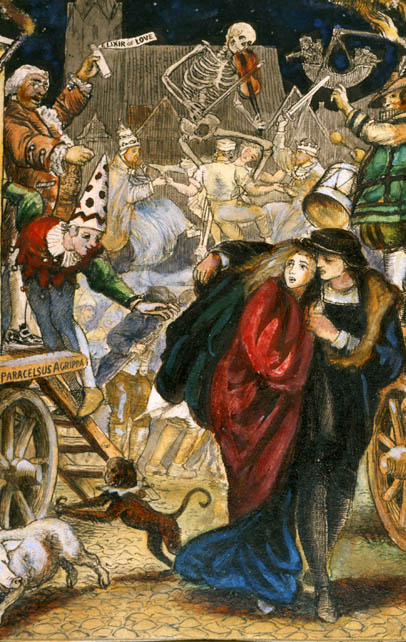
Wonderland: 1912
_1912.jpg)
The Rescue
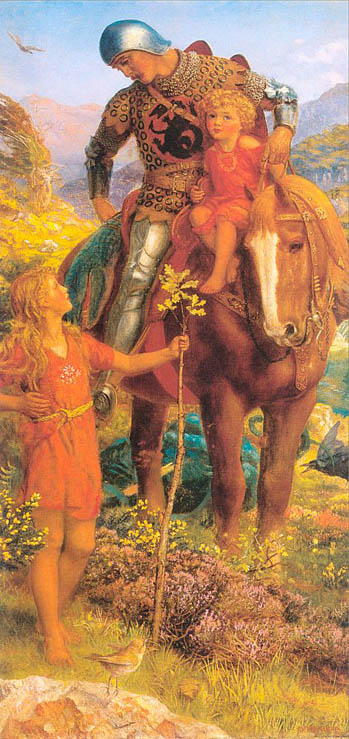
The Enchantress: 1870-74

Datable to the early 1870's, this picture is probably a sketch for a larger picture that was then never begun. A work by Hughes of the mid-1860's entitled 'Mariana at the Window' includes the same sort of diaphanous material worn by the model in our picture. When sold in 1937 and 1942 the sitter was thought to be Ellen Terry, although recent scholarship has cast doubt on this suggestion.
The Lady of Shalott: ca 1863
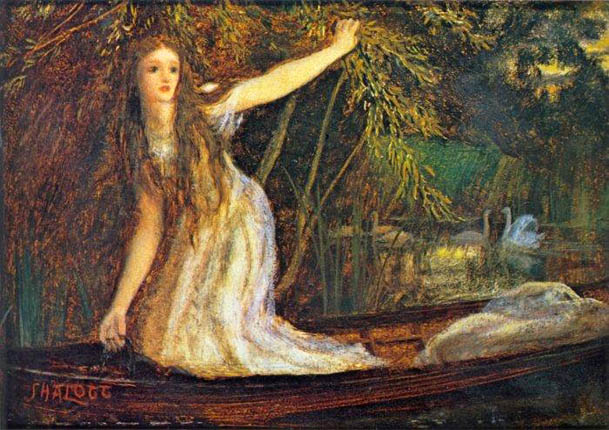
An Earlier Version of this Pre-Raphaelite Subject
Will o' the Wisp
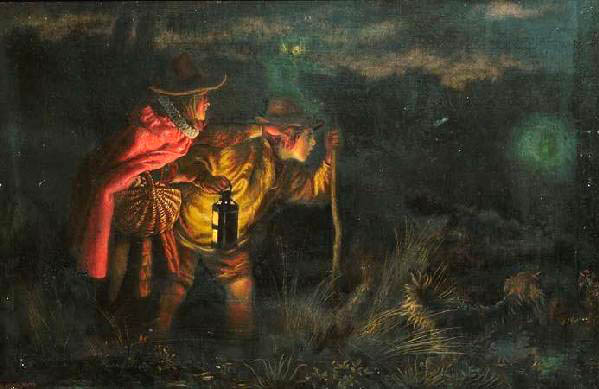
The will o' the wisp or 'ignis fatuus', or in plural form as 'ignes fatui' ("fool's fire(s)") is the phenomenon of ghostly lights sometimes seen at night or in twilight hovering over damp ground in still air, often over bogs. The will o' the wisp is said to recede if approached. Much folklore has attached to the legend, despite possible scientific explanations.
Source: Art Renewal Center
Source: Arthur Hughes Online
This page is the work of Senex Magister
Return to Pagina Artis
Return to Bruce and Bobbie's Main Page.















 _1860.jpg)


























_ca_1857_62.jpg)











_1912.jpg)



